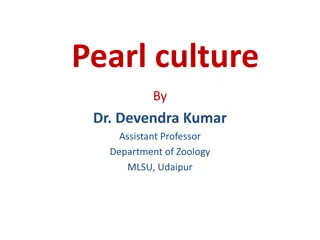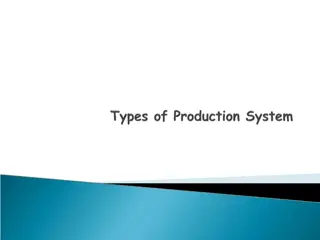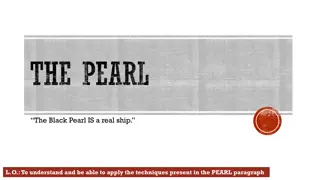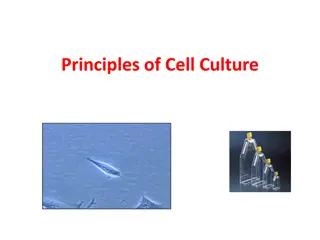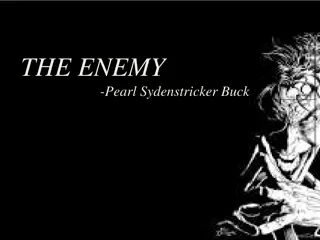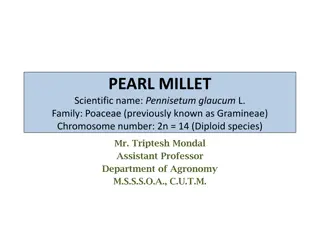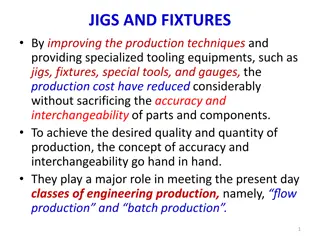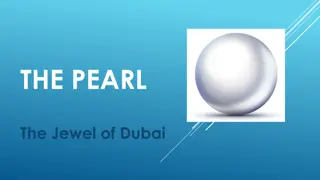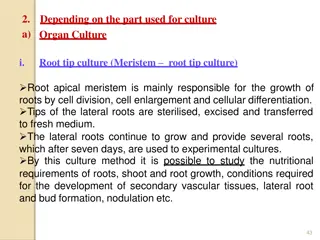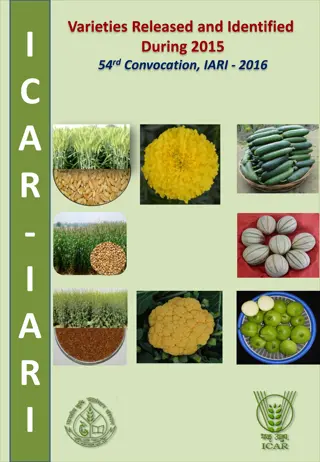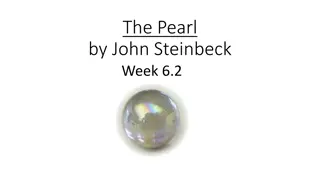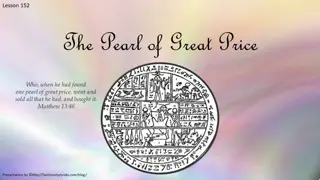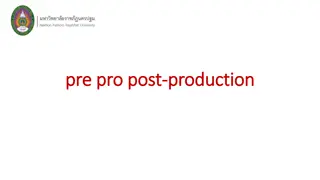Fascinating Insights into Pearl Culture and Production
Pearls are formed by mollusks in saltwater or freshwater, with cultured pearls being a popular choice today. Learn about the different forms of pearls, their historical significance, modern industry trends, and the value of cultured South Sea pearls in the market. Explore the rich world of pearl culture and production in this comprehensive guide.
Download Presentation

Please find below an Image/Link to download the presentation.
The content on the website is provided AS IS for your information and personal use only. It may not be sold, licensed, or shared on other websites without obtaining consent from the author.If you encounter any issues during the download, it is possible that the publisher has removed the file from their server.
You are allowed to download the files provided on this website for personal or commercial use, subject to the condition that they are used lawfully. All files are the property of their respective owners.
The content on the website is provided AS IS for your information and personal use only. It may not be sold, licensed, or shared on other websites without obtaining consent from the author.
E N D
Presentation Transcript
PEARL CULTURE Pearl producing organisms Pearls are formed by saltwater or freshwater mollusks (Pinctada roding) a diverse group of animals that includes oysters, mussels, clams, conchs, and gastropods. Pearls form inside a mollusk which is an invertebrate with a soft body, often protected by a shell such as a clam, oyster or mussel. Any mollusk is capable of producing a pearl, although only those mollusks that have shells lined with nacre produce pearls.
CULTURED PEARLS Cultured pearls are real, genuine pearls that are formed inside a living oyster When a nucleus is surgically implanted in the oyster's flesh, the oyster recognizes it as an irritant and begins to coat it with smooth layers of nacre. Over time, the growing pearl gets completely covered with the beautiful iridescent substance we call nacre, or MOTHER-OF-PEARL. All pearls sold today are cultured pearls.
FORMS OF PEARLS Pearls can be formed in three ways. Ampulla pearls are formed in the pockets or ampulla of the epidermis. are formed around Muscle calcospherules at the insertion of the muscles. pearls are formed when parasitic Cyst worms build cysts, located in the connective tissue of the mantle (outer layer) and within the soft tissues of the concentric layers of nacre are deposited. pearls body, around which
HISTORY OF PEARLS Pre-historic times Pearls shells as decorative objects in Egypt Religious texts; Bible Mythological and cosmological terms 1893-first cultured pearl-by Koki chi mikimoto Introduced irritant in oyster to stimulate pearl formation
MODERN INDUSTRY PEARLPRODUCTION INDUSTRIES in more than 30 countries China has largest production Analysis of FAO global statistics-in past decade-Chinese pearls -3540 tons weigh-worth 15 million$
Japan has been the worlds major marine pearl producer for over a century average annual-Japan was 127 million$, accounting for 51.6% of global pearl output value global pearl production fell by 60% while output value fell by 39% over the past decade.
Cultured South Sea Pearls These are considered to be the most valuable type of cultured pearl on the market. One strand of South Sea pearls can range between $1,000 to $100,000.
REARING OR FARMING OF OYSTER Oyster farming is an aquaculture practice in which oysters are bred and raised mainly for their pearls, shells and inner organ tissue, which is Oyster farming was practiced by the ancient Romans as early as the 1st century BC on the Italian peninsula and later in Britain for export to Rome eaten
REARING OF OYSTER Steps Temperature and salinity of water are controlled Conditioning broodstock Putting oysters in tray After spawning initiation they can be placed in containers After two weeks oyster will be ready to set Putting larvae in a system Spat formation
METHODS OF CULTIVATION Bottom culture Traditional method bottom culture method means the oysters are growing on the ocean bottom
Suspended tray method Rack and Bag method Oysters which are cultivated by the suspension method are the prima donnas of oyster Using steel racks placed into the sand or mud bottom, plastic mesh bags filled with small oysters are laid across the tops of the racks They are suspended, in mesh trays or a Japanese lantern shaped nets, in deep water their entire lives, protected from predators, mud, sand and silt By elevating the bags of oysters off of the bottom, the oysters are able to feed better and grow faster; the bags also protect the young oysters from predators they can hang below the surface of the water 24 hours per day allowing for the oysters to grow very fast.
COMPOSITION OF PEARL Ideal pearl is round and smooth but many other shapes are present Organic matter =5.94% Carbonate of lime =91.72% Water =2.34% Quality of pearls is determined by its keratin content and color. CaCo3 is in the form of minute crystalline form, which has deposited in concentric layers
FORMATION OF PEARL Stages in the pearl formation Preparation of host cell Nucleus insertion Convalescence Pearl formation Harvesting Processing of pearls
PREPARATION OF HOST SHELL In nature pearls may be formed in different region of the body namely the region of adductor muscles, mantle margin, pallial zone The best side for pearl production is considered to be the gonadal region, spent individuals serves as good host Nucleus is inserted in the gonadal region
NUCLEUS INSERTION It involves selection of suitable donor shell or any other After obtaining the nucleus and graft tissue the recipient object for obtaining the nucleus material and donor oyster or mussel for obtaining graft tissue oyster will be operated upon and the nucleus implanted in the gonadal region The size of the nucleus determines the size of the graft tissue The time and number of nuclei to be implanted will be determined in advance
CONVALESCENCE AND PEARL FORMATION After operation the mussel are allowed to be recover the disturbance caused and then oyster are kept in cages The graft tissue on the nucleus grows into a pearl sac The epithelial cells of the pearl sac deposit nacreous layer around the nucleus, which ultimately leads to the formation of pearl In pearl oyster it takes 3 to 4 years of commercial value to develop In freshwater mussel pearls are harvested 2-3 years after implantation
HARVESTING OF PEARLS Oysters or mussel with pearls are brought to the laboratory The valves are open and the fleshy parts are extracted out and then pearls are obtained by pulverizing the extracted parts Pearls are almost harvested in winter and during cold month the metabolism of host oyster has decreased After the pearls harvested than pearls can be cleaned and polished before treating Agood harvest is determined by the number of marketable pearls produced
PROCESSING OF PEARLS Soon after their separation from the meat, pearls are washed with water. to remove the mucilaginous matter and maintain the luster. The pearls are then graded according to size.
PROCESS OF PEARL CULTURING Following are the steps of pearl culturing. Construction of pearl farm. Collecting oyster Seeding Carving the oyster
CONSTRUCTION OF FARM AND COLLECTION OF OYSTER Construction of farm require : Selection of farm site. 1. Preparation of farm. 2. Well planned work schedule. 3. Next step is to collect oyster. Oyster are located at the bottom of flat rock. They are covered with a layer of animals and slit layer.
METHODS IN PEARL CULTURING There are mainly two steps of pearl culturing. Harvesting ( it is necessary to harvest early to determine whether pearls have sufficient coating or not). 1. Sorting pearls (the pearls are sorted in order to check that they can be used in industry or not) . 2.
PEARL CULTURING AND BIOLOGICAL ENVIRONMENT Environmental pollution is putting severe effects on pearl culturing. The main reason of pearl farms deterioration is the occurrence of red tides . Because of infectious diseases like herpes, avian influenza pearl industry is disrupting day by day. Japan dominated the world s cultured pearl but it is declining drastically now a days.
USES OF PEARLS Digestive tract, skin and muscular problems Mixed with herbal powders and potions Balance hormonal level in human body Skincare agent Anti-aging and anti-acne Spiritual healer Strengthen the emotional powers In ancient times Gem Therapy has also been used to reinforce nervous system






